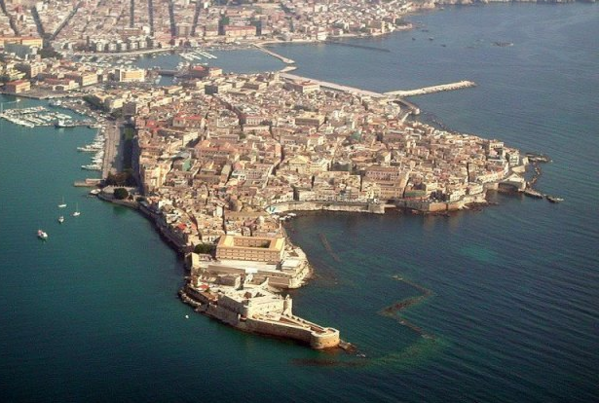When ancient Syracuse was a key city in the Greek world, Ortigia was Syracuse, and in some ways it still is.
Ortigia is a large island facing the modern city, with the city's cathedral and an array of building styles from ancient to not-as-long-ago, including traces of 200 years of Muslim rule from the 9th to 11th centuries.

An afternoon is clearly not enough for Ortigia, but road construction and traffic cut our time to that, and our energy level to lunch and a long walk, but even so, there was plenty to see, starting with the snack options next to the waterfront parking lots that take most cars off the island streets).
Both of these vendors had other foods available, but local citrus played the star role, especially in the signature drink of eastern Sicily: Selz e Limone, a tart and refreshing mix of seltzer and lemon juice and a bit of salt. It's also made with other flavors, but purists say...
The area near the port, which still handles small cargo and fishing boats as well as pleasure boats, has some of the newer buildings, and quite a number of restaurants. Surprisingly, once we settled for the night in an apartment in modern Syracuse, we found no restaurants nearby: All the listings were in or next to Ortygia! We ended up ordering with the Italian equivalent of Seamless, called JustEat.
Starting up the hill from the port, we walked through a warren of old, small streets, occasionally seeing into a piazza or a courtyard. And then, suddenly, at the head of a street, we found ourselves in the huge Piazza Duomo, opposite the Cathedral.
As impressive as the Cathedral and its neighbors are, the building hides a story. Although a quick glance says Sicilian Baroque, the facade hides a 2500-year-old Greek temple dedicated to Athena, and since used as a Christian church and a mosque, depending on who ruled the island. For more on the Cathedral from TravelGumbo, click HERE.
Also on the Piazza Duomo are the Bishop's Palace, and the much-less-impressive-looking church dedicated to Saint Lucy, the city's patron, whose relics are displayed in the cathedral, and a number of government and commercial buildings—as well as a tempting array of cafes and restaurants. St. Lucy's church does have a nice carving above the door, though.
Walking on from Piazza Duomo, we drifted through more streets and more interesting buildings; it can have both a monumental feel and an intimate one, with even the narrow space of a car-free street serving as an outdoor restaurant.
And while there's a lot of stone packed into the narrow streets, it's not without a share of growing things, including Sicily's signature citrus: lemons, for which the Syracuse area is renowned.
We noticed a number of buildings with quite a display of window boxes and planters, too.
You don't have to walk far to remember that Ortigia is an island, though each of its shores has a different aspect. Most of the harborage is at the north; the southern point of the island ends in ancient fortifications.
As we moved back toward the north of the island, we came to Ortigia's Fountain of Arethusa, with papyrus plants. It's supposedly where the nymph of that name, escaping from underwater Arcadia, returned to earth. If you didn't know the story (we didn't at the time), it's still a pleasant stop on the walk.
Approaching the port, we came upon the obligatory statue, found everywhere in Sicily, of Garibaldi. As in most places, it's twinned with the name of Emmanuel Vittorio I, the first king of unified Italy. In this case, the 'corso' the statue faces is named for him. It continues along the passage under the box-trimmed trees.
Further along our walk, we found that we had missed the day's activity in the handsome 19th-century market building, but an informal market continued outside...but nothing edible!
Quite a few buildings have icons like this built into facades or corners of the building. You can tell by the knife in her neck that it's the martyred St. Lucy.
And how could there not be a place for this building before we wandered off into the sunset and the search for our apartment and dinner?


Comments (0)